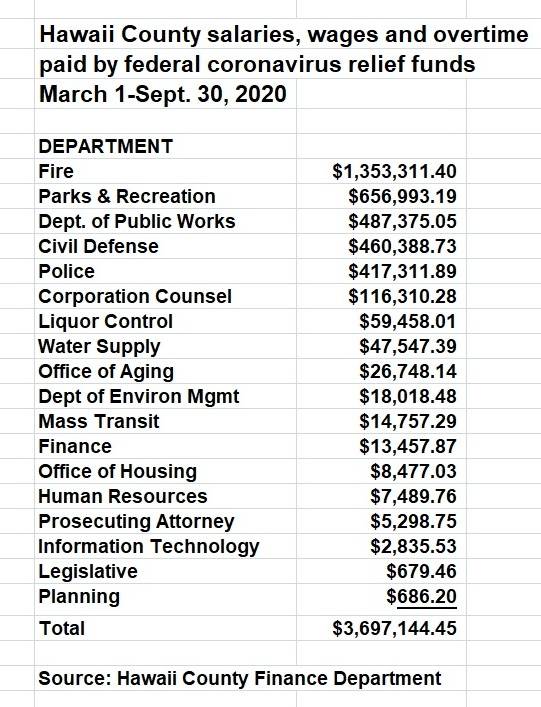The federal government picked up $3.7 million for salaries, wages and overtime of county employees during the first seven months of the coronavirus pandemic, according to data released by the county Department of Finance in response to a West Hawaii Today public records request.
As expected, the bulk of the reimbursements, $2.5 million, were for emergency responders and workers in the Parks and Recreation and Public Works departments, tasked with sanitizing public facilities. The Fire Department, which includes lifeguards, emergency medical services and ambulances cut by the state, alone accounted for almost $1.4 million of that.
County workers are part of task forces, in addition to working their regular jobs. The “bug busters” task force, composed of Public Works and Parks and Recreation staff, is dedicated to keeping environs clean, from public facilities to some private ones on an as-needed basis. Staff from other departments also volunteer at Civil Defense’s Emergency Operations Center phone bank to respond to COVID-19 calls.
Those departments were followed by Civil Defense, Police and Corporation Counsel, which together accounted for another $994,000.
Asked what civil attorneys are doing for their $116,000, Deputy Finance Director Steven Hunt said they’re essential in interpreting and drafting proclamations, writing contracts and requests for proposals for outside agencies handling funds and they have a seat at the table for thrice-weekly meetings with state Emergency Management Agency officials.
“They interpret the governor’s proclamations, help draft the mayor’s proclamations,” Hunt said Thursday. “They’re pretty involved in all those things.”
Mayor Harry Kim could not be reached for comment. But Hunt provided additional information by email in a response to an inquiry to the mayor’s office.
“We are still compiling and reconciling October’s expenditures that will be expensed to the Coronavirus Relief Fund. Because it’s been a very fluid situation, it’s difficult to comment of the salaries and overtime at this juncture,” he said. “Opening rapid testing sites at the Kona and Hilo airports will likely result in somewhat higher personnel costs as our employees contributed significantly to getting that operation off the ground.”
Facing a Dec. 30 use-it-or-lose-it deadline to spend its $80 million allotment from the Coronavirus Aid, Relief, and Economic Security (CARES) Act, the county is on track to spend it all, Hunt told the County Council last month. If there is anything left over as the deadline nears, the county will buy extra personal protective equipment, sanitizer and shelf-stable food, he said. The most recent report showed $32.9 million spent, $21.2 million encumbered and $25.8 million committed to be spent by the deadline.
The federal government is paying for expenses attributed to COVID-19 prevention and recovery over and above regular costs. Salaries and wages typically account for 60% to 65% of the county’s $585 million operating budget.



